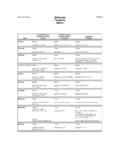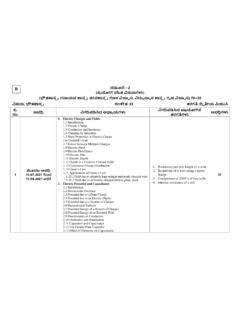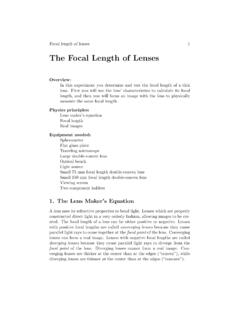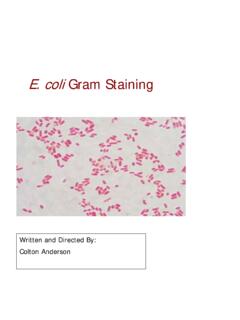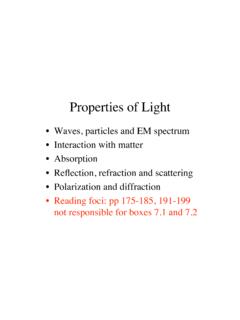Transcription of Microscopy I Light and Electron Microscopy
1 Microscopy ILight and Electron MicroscopyReplica of van Leeuwenhoek s(1632-1723) microscope constructed c. 1670. Moody Medical Library, Univ. Texas Medical Branch, Galveston, TXUse the information in this tutorial to supplement the visuals in lab and the information in Chapters 1, 8 and 9 in your lab manual .Replica of Culpepper tripod microscope built c. 1725 by Edmund Culpepper (1670-1738). Collection of Moody Medical Library, Univ. Tex., Galveston, TX. (Replica by Replica Rara Ltd. Antique Microscopes)ContentsI. Types of MicroscopyA. Light Microscopy1. Brightfield2. Darkfield3. Phase Contrast4. Polarizing5. DIC6. laser scanningB. Electron Microscopy1. Scanning2. TransmissionII.
2 Specimen PreparationA. Light MicroscopyB. Scanning Electron MicroscopyC. Transmission Electron MicroscopyReplica of Marshall Microscope, c. 1700, by John Marshall (1663-1725). Collection of Moody Medical Library, Univ. Texas, Galveston, TXMicroscopes have long been essential tools of cell biologists. This tutorial provides a brief overview of types of microscopes commonly used in biological studies and general techniques for preparing specimens for the various types of Microscopy . The two broad categories of Microscopy we are concerned with are: Light Microscopy (LM)and Electron Microscopy (EM)Old monocular brightfield microscope with fixed stage and , bright field microscope with movable stage, dioptic adjustment, condenser and iris diaphragm, and built-in Light source.
3 These are used as clinical, research and student MicroscopyBright field Microscopes--the most common general use microscopes. Bright field microscopes are named because the microscopic field is bright, while the object being viewed is Simple design- Light directed at specimen is absorbed to form image- Unstained specimens have poor contrast- Stained specimens show excellent contrast- Ideal for stained bacteria, cells, tissues- High , good resolution- Bright background, dark specimen- tungsten or halogen Light sourceBright field images--Flagellate --Trichomonas Stained blood cells in peripheral blood smearSection of gut tissue containing ciliated parasites Inverted microscope.
4 Position of Light source and objectives is inverted -- Light source is above specimen and objective lenses are located beneath the stage. LightObjectivesThe basic design of bright field microscopes has been modified for special uses. Inverted microscopes(right) allow viewing of cells in flasks, welled-plates, or other deep containers that do not fit between the objectives and stage of standard BF field Microscopes (DF)The dark field microscope creates a dark background to allow viewing of small unstained objects, such as motile bacteria, that would be difficult to view in a bright field. The central portion of the Light is blocked so that only oblique Light strikes the specimen, scattering Light rays that then enter the objective to form the A method from the 19th century- Bright specimen, dark background- Light not scattered by the specimen bypasses the objective, therefore making the field dark.
5 - Can see very small objects but resolution is variable-High contrast, good for unstained, live, and motile specimensLeptospira,a spirochete,viewed with darkfieldmicroscopyDarkfield Images--The algae Hydrodictyonreticulatumviewed with darkfield Microscopy . Photo by Dr. D. Folkerts, Contrast--Converts differences in refractive index in a specimen to differences in image central portion of the Light source is blocked, creating a ring of Light from the condenser that illuminates the specimen. The Light waves refracted by the specimen are slowed by a phase retardation plate (in phase objectives) increasing the difference in wavelength between refracted and unrefractedrays (which do not pass through the phase plate).
6 When the refracted and and unrefracted waves are focused, they produce an interference due to the difference in wavelengths--this is seen as differences in brightness in the specimen. - technology from 1940 s- provides high contrast, good resolution- good for bacteria, flagella, cilia, organelles such as mitochondria- good for unstained or live mounts- phase halos (artifacts) occurAnnular ring Phase objectivesPhase Contrast Image (left)--compared with DIC image (right)Unstained squamous epithelial cells observed with phase contrast Microscopy (above) and DIC Microscopy (right). Differences in refractive index in various regions of the cells account for contrast in the images. (From Becker et al.)
7 , The World of the Cell, Benjamin/Cummings Publ. Co., 2000.)Polarization MicroscopyDetects specimens that are birefringent(have the characteristic of double refraction, the velocity of Light refracted by a substance is not the same in all directions). The specimen is placed between two polarizers crossed at 90oto each other (one in condenser and one in objective).-bright image, dark background- used for substances with highly organized molecular structure, such as crystals, minerals- can be quantitativePolarizerPolarizerSpecimenPo larizing Microscopy images--many crystals and minerals display characteristic patterns in polarizing lightLeft, portion of Martian meteorite that has been ground to mm depth and viewed under polarizing Microscopy (From Calvin J.
8 Hamilton). Top right, BF view of renal epithelial cells containing fat globules; bottom right, high magnification view of same cells viewed with polarizing microscope and showing typical maltese cross formation displayed by fat in polarized Light . (From R. Hyduke, U. Iowa Hospitals & Clinics.)Epi-fluorescence MicroscopyAllows the detection of molecules and ions within cells. Fluorescent dyes absorb short wavelengths of Light and emit longer wavelengths. Barrier filters and a dichroicprism select the excitation wavelength that strikes the specimen and exclude the excitation wavelength from the detector, allowing only emitted Light to reach the detector (oculars).-uses uv Light source = mercury or xenon arc lamp.
9 - high contrast, high resolution image- special fluorescent dyes used to locate molecules in a specimen- black background, bright-stained specimen- no condenser required, Light comes from above ( epi ) specimen- multiple fluorescent probes available- detects small quantities, molecules; can use antibody staining techniquesUV Light sourceBarrier filters and dichroic prismEpi-fluorescent images--The locations of specific molecules can be identified using fluorescent probes. In immunofluorescencetechniques, antibody probes that bind to the molecules and secondary antibody labeled with a fluorescent dye are ofTetrahymena, a ciliated protozoan, using the fluorescent dye, fluorescein isothiocyanate, which emits green Light .
10 Above left, cell is stained with anti-basal body antibody; above right, cell is stained with antibody against cell membrane surface antigen. Compare the information obtained using the fluorescent technique with the BF view of Tetrahymena(far right) stained with image showing metaphase in newt lung cell. Three fluorescent probes--specific for DNA, keratin, and tubulin--were used. Blue, metaphase chromosomes (DNA); red, keratin filaments;yellow, spindle apparatus made of microtubules. From ASCB, Bethesda, MD; image by Rieder and Hughes, NY State Dept. Health, Albany, Interference Contrast (DIC) Microscopy --also called NormarskiopticsResembles phase-contrast but more sensitive--gives higher resolution.







